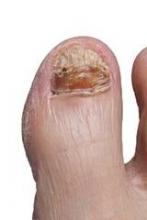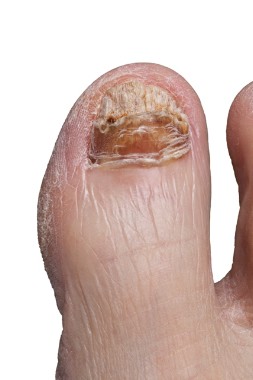User login
NEW YORK – Diagnosis of fungal nail infection with polymerase chain reaction is demonstrating that the rates of mixed infection, including coinfection with dermatophyte and nondermatophyte molds, are substantially higher than that produced by cultures, according to a series of studies with implications for treatment selection.
The data may explain why some infections persist despite therapy and could lead to more frequent use of PCR as a diagnostic tool, Dr. Aditya K. Gupta reported at the American Academy of Dermatology summer meeting.
PCR is far more sensitive than culture for identification of dermatophytes and nondermatophytes, and, unlike culture, PCR can detect the presence of multiple fungi in the same sample, according to Dr. Gupta, a dermatologist at Sunnybrook and Women’s College Health Sciences Center, Toronto.
Based on studies at his institution, he reported that two or more pathogens are more common than previously appreciated "and this is really important," because it has immediate implications for selecting broader spectrum agents to increase the likelihood of mycologic cure.
"A lot of treatment failures that we attribute to lack of efficacy of the agent may in fact be a reflection of the fact that there is a nondermatophyte mold that is present, evading therapy," Dr. Gupta said.
In a series of 155 patients, PCR was positive for dermatophytes in 44% of patients when culture was positive in 20%. Positive findings were 14% and 7% for PCR and culture, respectively, for nondermatophytes.
PCR is now being used routinely at Dr. Gupta’s institution not only because of its ability to detect mixed infections but also because it is about twice as sensitive as culture for detecting nail fungi.
Dr. Gupta predicted wider use of PCR in onychomycosis because of its greater sensitivity, noting however, that cost may be an obstacle. The potential difficulty of obtaining third-party reimbursement for PCR, which is substantially more expensive than a culture is, was raised in the discussion period by several dermatologists who were impressed with these results. At Dr. Gupta’s center, cost has not been an issue because PCR is being performed as part of a research initiative, but the greater diagnostic accuracy may be relevant to a cost-benefit analysis that includes an opportunity to increase the proportion of patients initiated on an optimal therapy for the underlying pathogen, Dr. Gupta said.
Dr. Gupta reported that he has financial relationships with Valeant, NuvoLase, Bristol-Myers Squibb, Novartis, and Janssen. The study was not commercially sponsored.
NEW YORK – Diagnosis of fungal nail infection with polymerase chain reaction is demonstrating that the rates of mixed infection, including coinfection with dermatophyte and nondermatophyte molds, are substantially higher than that produced by cultures, according to a series of studies with implications for treatment selection.
The data may explain why some infections persist despite therapy and could lead to more frequent use of PCR as a diagnostic tool, Dr. Aditya K. Gupta reported at the American Academy of Dermatology summer meeting.
PCR is far more sensitive than culture for identification of dermatophytes and nondermatophytes, and, unlike culture, PCR can detect the presence of multiple fungi in the same sample, according to Dr. Gupta, a dermatologist at Sunnybrook and Women’s College Health Sciences Center, Toronto.
Based on studies at his institution, he reported that two or more pathogens are more common than previously appreciated "and this is really important," because it has immediate implications for selecting broader spectrum agents to increase the likelihood of mycologic cure.
"A lot of treatment failures that we attribute to lack of efficacy of the agent may in fact be a reflection of the fact that there is a nondermatophyte mold that is present, evading therapy," Dr. Gupta said.
In a series of 155 patients, PCR was positive for dermatophytes in 44% of patients when culture was positive in 20%. Positive findings were 14% and 7% for PCR and culture, respectively, for nondermatophytes.
PCR is now being used routinely at Dr. Gupta’s institution not only because of its ability to detect mixed infections but also because it is about twice as sensitive as culture for detecting nail fungi.
Dr. Gupta predicted wider use of PCR in onychomycosis because of its greater sensitivity, noting however, that cost may be an obstacle. The potential difficulty of obtaining third-party reimbursement for PCR, which is substantially more expensive than a culture is, was raised in the discussion period by several dermatologists who were impressed with these results. At Dr. Gupta’s center, cost has not been an issue because PCR is being performed as part of a research initiative, but the greater diagnostic accuracy may be relevant to a cost-benefit analysis that includes an opportunity to increase the proportion of patients initiated on an optimal therapy for the underlying pathogen, Dr. Gupta said.
Dr. Gupta reported that he has financial relationships with Valeant, NuvoLase, Bristol-Myers Squibb, Novartis, and Janssen. The study was not commercially sponsored.
NEW YORK – Diagnosis of fungal nail infection with polymerase chain reaction is demonstrating that the rates of mixed infection, including coinfection with dermatophyte and nondermatophyte molds, are substantially higher than that produced by cultures, according to a series of studies with implications for treatment selection.
The data may explain why some infections persist despite therapy and could lead to more frequent use of PCR as a diagnostic tool, Dr. Aditya K. Gupta reported at the American Academy of Dermatology summer meeting.
PCR is far more sensitive than culture for identification of dermatophytes and nondermatophytes, and, unlike culture, PCR can detect the presence of multiple fungi in the same sample, according to Dr. Gupta, a dermatologist at Sunnybrook and Women’s College Health Sciences Center, Toronto.
Based on studies at his institution, he reported that two or more pathogens are more common than previously appreciated "and this is really important," because it has immediate implications for selecting broader spectrum agents to increase the likelihood of mycologic cure.
"A lot of treatment failures that we attribute to lack of efficacy of the agent may in fact be a reflection of the fact that there is a nondermatophyte mold that is present, evading therapy," Dr. Gupta said.
In a series of 155 patients, PCR was positive for dermatophytes in 44% of patients when culture was positive in 20%. Positive findings were 14% and 7% for PCR and culture, respectively, for nondermatophytes.
PCR is now being used routinely at Dr. Gupta’s institution not only because of its ability to detect mixed infections but also because it is about twice as sensitive as culture for detecting nail fungi.
Dr. Gupta predicted wider use of PCR in onychomycosis because of its greater sensitivity, noting however, that cost may be an obstacle. The potential difficulty of obtaining third-party reimbursement for PCR, which is substantially more expensive than a culture is, was raised in the discussion period by several dermatologists who were impressed with these results. At Dr. Gupta’s center, cost has not been an issue because PCR is being performed as part of a research initiative, but the greater diagnostic accuracy may be relevant to a cost-benefit analysis that includes an opportunity to increase the proportion of patients initiated on an optimal therapy for the underlying pathogen, Dr. Gupta said.
Dr. Gupta reported that he has financial relationships with Valeant, NuvoLase, Bristol-Myers Squibb, Novartis, and Janssen. The study was not commercially sponsored.
AT THE AAD SUMMER ACADEMY 2013
Major finding: PCR is twice as effective as culture for the identification of pathogens causing onychomycosis.
Data source: Single-center study comparing diagnostic techniques in patient series
Disclosures: Dr. Gupta reported that he has financial relationships with Valeant, NuvoLase, Bristol-Myers Squibb, Novartis, and Janssen. The study was not commercially sponsored.

